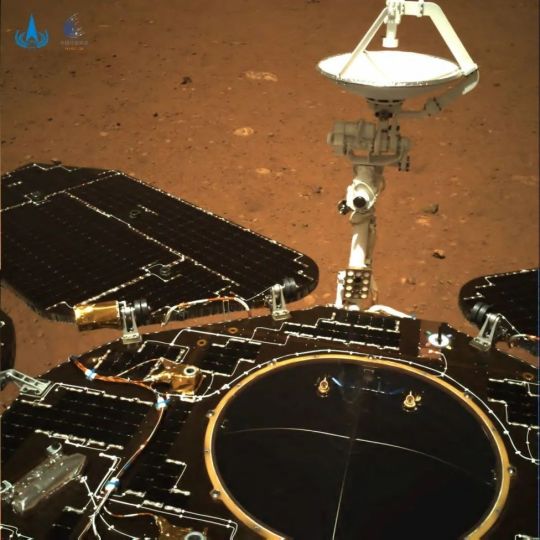#mars china zhurong rover land touch ground cnsa zhurong
Text
Zhurong: China Mars Rover Touches Ground on Red Planet
Zhurong: China Mars Rover Touches Ground on Red Planet
China’s first Mars rover has driven down from its landing platform and is now roaming the surface of the red planet, China’s space administration said Saturday.
The solar-powered rover touched Martian soil at 10:40am Saturday Beijing time (8:10am IST), the China National Space Administration said.
Now I’m “literally” on Mars surface. At UTC 2:40, May 22, #Zhurong (#Tianwen1) Mars Rover drove…

View On WordPress
0 notes
Text
Zhurong: China Mars Rover Touches Ground on Red Planet
Zhurong: China Mars Rover Touches Ground on Red Planet
China’s first Mars rover has driven down from its landing platform and is now roaming the surface of the red planet, China’s space administration said Saturday.
The solar-powered rover touched Martian soil at 10:40am Saturday Beijing time (8:10am IST), the China National Space Administration said.
Now I’m “literally” on Mars surface. At UTC 2:40, May 22, #Zhurong (#Tianwen1) Mars Rover drove…

View On WordPress
0 notes
Text
Zhurong: China Mars Rover Touches Ground on Red Planet
Zhurong: China Mars Rover Touches Ground on Red Planet
China’s first Mars rover has driven down from its landing platform and is now roaming the surface of the red planet, China’s space administration said Saturday.
The solar-powered rover touched Martian soil at 10:40am Saturday Beijing time (8:10am IST), the China National Space Administration said.
Now I’m “literally” on Mars surface. At UTC 2:40, May 22, #Zhurong (#Tianwen1) Mars Rover drove…

View On WordPress
0 notes
Text
Listen to the eerie noise of China's Mars rover as it sets off to explore
https://sciencespies.com/space/listen-to-the-eerie-noise-of-chinas-mars-rover-as-it-sets-off-to-explore/
Listen to the eerie noise of China's Mars rover as it sets off to explore
China has released video and sound clips from its rover exploring the surface of Mars.
The files were published by China National Space Agency on Sunday.
The sound is of the Zhurong rover leaving its lander before taking its first ride in May, and can be heard in the video below.
[CNSA video 2/4] Sound of #Zhurong Mars rover rolling off from lander to Mars surface. pic.twitter.com/Uh41Yiy1w6
— CNSA Watcher (@CNSAWatcher) June 27, 2021
The eerie noises are made by the rover moving on the rack, said Jia Yand, deputy chief designer of the Mars rover project
The sound is somewhat muffled, and doesn’t quite sound like what could be expected on Earth.
It could provide clues about the environment and conditions on Mars, including figuring out the density of the atmosphere, according to Jizhong, deputy commander of the exploration program.
Liu said its main purpose is to listen to the wind.
This is not the first sound recording to come back from Mars.
NASA’s Perseverance rover, which landed about a month before Zhurong, sent back its first audio recording in February.
Since then, NASA has released more sounds from Mars, including the sounds of the rover driving around and of its laser firing at rocks.
A new Martian panorama, and footage of the rover launding
Since it landed in May, the rover has moved 236 meters (about 774 ft), CNSA said.
A video shows a 360 degree view caught by the rover’s onboard camera. Its tracks lead to the lander which can be seen in the distance.
Video from Mars taken by #Zhurong #Tianwen1 Mars Rover. New video and images include 3D stereo of supersonic parachute deployment, landing process, sound of the rover driving away from lander, rover maneuver and panorama in a distance from lander. HD Full: https://t.co/q8vGOWUxjG pic.twitter.com/eBUbPnvS81
— CNSA Watcher (@CNSAWatcher) June 27, 2021
The full 360-degree panorama can be seen here.
Another video, below, shows the rover backing away from a camera that it dumped it on the ground to take a selfie with its lander platform. It can be seen rotating in place, showing that it is in good working condition, the China National Space Agency (CNSA) said.
[CNSA video 3/4] Video of #Zhurong Mars rover moving backwards. pic.twitter.com/uTcCHud03b
— CNSA Watcher (@CNSAWatcher) June 27, 2021
One last video released on Sunday shows the rover’s landing in May, including the deployment of its parachute and the moment it touched down.
[CNSA video 1/4] 3D stereo view of deployment of #Zhurong‘s supersonic parachute. pic.twitter.com/m5dTgHIu79
— CNSA Watcher (@CNSAWatcher) June 27, 2021
The rover is expected to remain active around another 48 days.
During its mission, it is meant to be analyzing the chemical make-up of Martian soil and looking for signs of water on the Utopia Planitia region where it landed, Insider’s Aylin Woodward reported on May 22.
This article was originally published by Business Insider.
More from Business Insider:
#Space
1 note
·
View note
Link
Zhurong Rover sent first selfie from Mars
#china#chinese#zhurong#tianwen-1#china mars landing#mars selfie#mars china zhurong rover land touch ground cnsa zhurong#mars china rover tianwen 1 zhurong landing successful cnsa xi jinping us nasa china
0 notes
Text
China’s First Mars Rover Has Sent Back New Images of the Red Planet
China’s Zhurong rover, the latest robot to land on Mars, has sent back its very first pictures of its new extraterrestrial home. Zhurong touched down on Mars on Saturday Beijing time, making China the second nation in history, after the United States, to land an operational surface mission on the red planet.
The view from the rover reveals the vast and desolate landscape of Utopia Planitia, one of the largest impact basins in the solar system, which stretches across 2,000 miles. Images released on Wednesday by the China National Space Administration include a black-and-white shot of the ramp that the rover will descend to start its exploration mission, as well as a backwards-facing shot of the rover in color, including its open solar panels and communications dish.

Image: CNSA
China’s space agency also released a short video of the rover separating from the nation’s orbiter so that it could make its descent to Mars.
Zhurong will soon roll off its perch on the lander and begin to drive around its site. The 500-pound robot is expected to explore Mars for at least a few months, and is tasked with taking pictures and conducting scientific measurements of the Martian terrain. The rover is equipped with instruments including a weather station, a magnetic field detector, and a ground-penetrating radar system to probe the Martian subsurface.
Zhurong’s historic landing follows a series of milestones at Mars that includes the arrival of the first orbiter from the United Arab Emirates, the February touchdown of NASA’s Perseverance rover, and the first controlled, powered flights on another world, performed by the Ingenuity helicopter. No matter how 2021 plays out here on Earth, it is sure to be a banner year for exploration on Mars.
China’s First Mars Rover Has Sent Back New Images of the Red Planet syndicated from https://triviaqaweb.wordpress.com/feed/
0 notes
Text
China’s Zhurong Mars rover lands safely in Utopia Planitia
https://sciencespies.com/space/chinas-zhurong-mars-rover-lands-safely-in-utopia-planitia/
China’s Zhurong Mars rover lands safely in Utopia Planitia
Chinese Mars rover makes it down to surface after months of preparation in orbit.
HELSINKI — China succeeded with its first planetary landing attempt Friday, safely setting down the solar powered Zhurong rover on the surface of Mars.
The 240-kilogram Zhurong rover touched down on the dunes of southern Utopia Planitia just after 7:00 p.m. Eastern May 14 after three months of preparations in orbit and around 8 minutes after entry into the Martian atmosphere.
The critical entry, descent and landing sequences were carried out successfully, with a final hazard avoidance hover phase allowing selection of a safe final landing spot.
Teams back on Earth will now prepare the rover, named after an ancient fire god, to complete a panoramic image of the landing area, perform systems checks and then descend from its landing platform and onto the Martian soil.
The rover will then begin an initial 90-day mission to explore and analyze the local area, climate, magnetic field and subsurface.
The achievement marks complete success for China’s Tianwen-1 mission, the country’s first independent interplanetary expedition which launched in July 2020 and entered Mars orbit Feb. 10.
China had previously landed on the near and far sides of the moon, in 2013 and 2019 respectively, before completing a complex lunar sample return late last year.
Zhurong is equipped with six science payloads, including a laser-induced breakdown spectroscopy instrument for analysing surface elements and minerals, panoramic and multispectral imagers, a climate station, magnetometer and a ground-penetrating radar.
It aims to return data on potential water-ice deposits, weather, topography and geology, complementing science carried out by missions from other space agencies.
China’s Tianwen-1 Mars rover undergoing thermal vacuum testing. Credit: CCTV/frame grab
After months of collecting high-resolution imagery to map its landing area, Zhurong targeted an area inside Utopia Planitia, understood to center on coordinates of 110.318 degrees east longitude and 24.748 degrees north latitude.
Planetary scientist Long Xiao with the China University of Geosciences told SpaceNews in February that “the most unique aim is to search and map the distribution of water ice on the surface and subsurface,” using sounding radars operating on both the rover and Tianwen-1 orbiter. The latter will conduct a global survey with a focus on polar and high latitude regions.
The presence of water ice at the low latitudes of Utopia Planitia could have implications for understandings of potential past or present habitability and was as future crewed Mars missions.
A high-resolution camera image of Utopia Planitia taken by Tianwen-1. Credit: CNSA/PEC
Zhurong’s climate station will also be valuable for future plans, says Maria Hieta, a space engineer at the Finnish Meteorological Institute, adding to data coming from other instruments carried by NASA’s Curiosity and Perseverance rovers and the InSight lander.
“Combining the measurements of all the weather stations will help us to better understand the Martian climate and will undoubtedly bring new information, and will also help us prepare for future human exploration,” Hieta says.
Tianwen-1 launched from Wenchang, south China, July 23, 2020 on a Long March 5 heavy-lift rocket, combining an orbiter and rover into one launch.
The mission built on technologies and capabilities developed through the Chang’e lunar program orbiters, lander and rovers, as well as head shielding and parachute expertise from Shenzhou human spaceflight endeavors.
The European Space Agency provided China with ground support for the Launch and Early Orbit phase and later during Earth-Mars transfer phases. ESA Mars Express HRSC (High Resolution Stereo Camera) and imaging spectrometer OMEGA also provided data and expertise to support characterization and selection of the Tianwen-1 landing sites.
China’s next Mars mission is expected to be a sample return attempt for around 2028-30.
A crescent of the northern hemisphere of Mars taken by Tianwen-1’s medium-resolution camera in March 2021. Credit: CNSA/PEC
#Space
0 notes